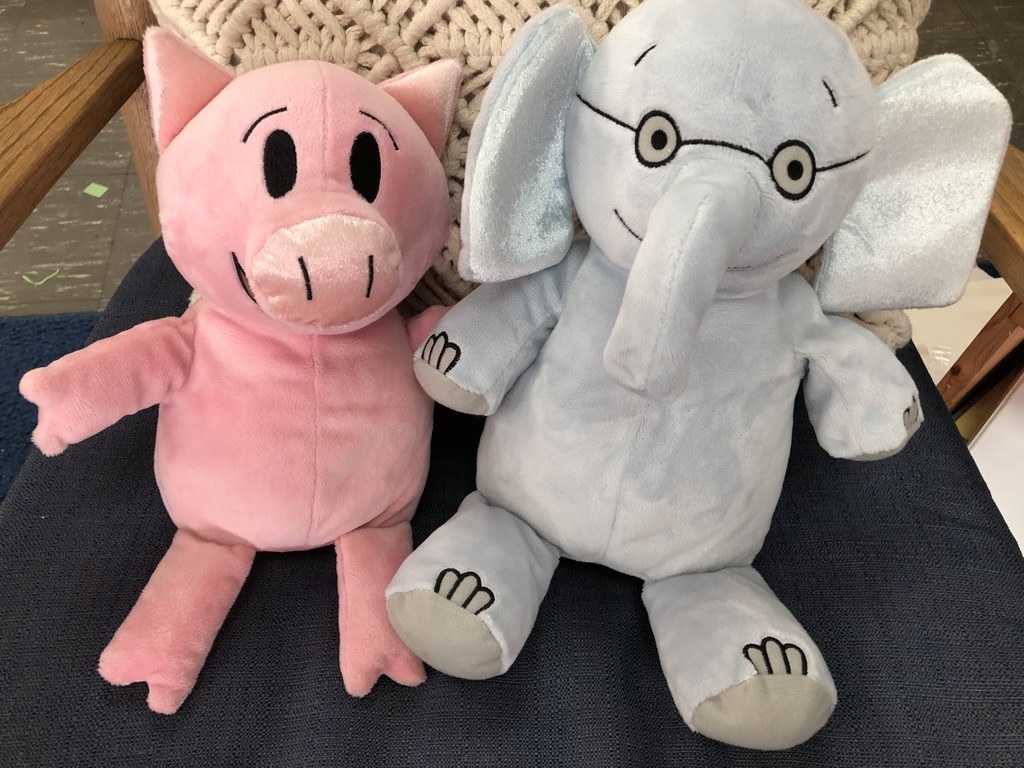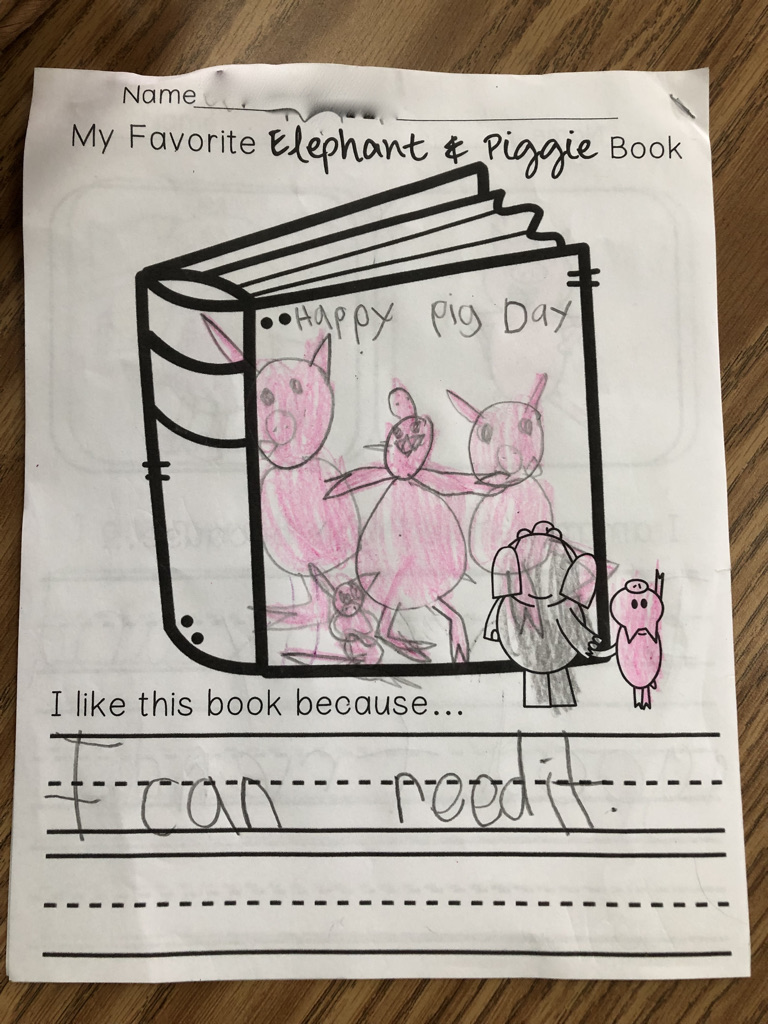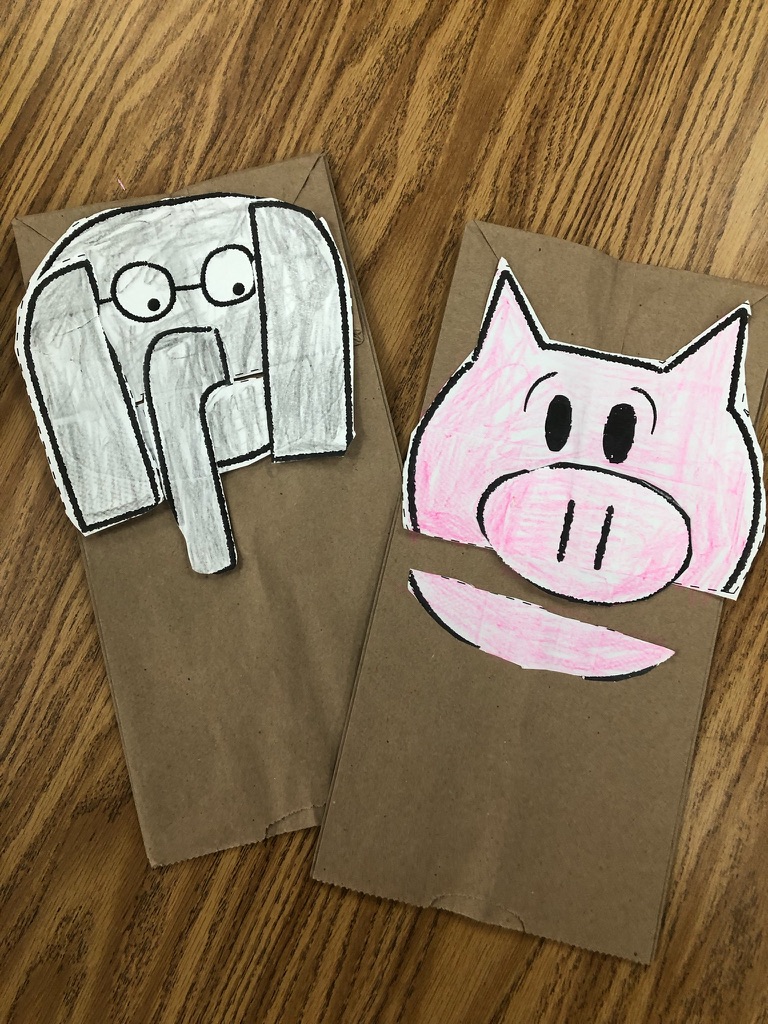Inside: Discover 10 ways you can use Elephant and Piggie books in kindergarten to teach language comprehension, expression, friendship, social emotional skills, and more!
It’s Elephant and Piggie Time!
April is rain, and mud, and worms and the month that I bring out the Elephant and Piggie books in kindergarten.
Spring fever has set in and engaging my kindergarteners is a bit harder than it was a few months ago.
Elephant and Piggie to the rescue!

By now we are all especially fond of the Pigeon and Knuffle Bunny, but many have not yet met Elephant and Piggie, and I’m literally giddy with excitement about introducing them!

Every minute spent with these adorable characters is pure joy for both parties involved, and while that might be enough incentive to run to your library and clear the shelves, here are 10 more reasons why they are my number one top pick for your kindergarten bookshelf!
1) Elephant and Piggie Show Good Character
The theme that runs through this entire series is friendship. These characters dually model what it looks and sounds like to be a good friend.
In, Listen to My Trumpet, Elephant struggles to find the best way to be honest with Piggie about her trumpet playing.

In, A Big Guy Took My Ball, Elephant sticks up for Piggie when someone bigger takes her ball.
In, Elephants Cannot Dance, Piggie encourages Elephant to try something he thinks he cannot do.
These are just a few examples, but you’ll find many more opportunities throughout the series to engage in character conversations with your children.
2) Elephant and Piggie Teach Feelings
I can’t think of a better book series to teach children about emotions than this one!
The illustrations clearly show expressions and body language that make it easy for young children to infer what the characters are feeling, and expand their vocabulary to include words like disappointed, embarrassed, frustrated, excited, anxious, nervous, and remorseful.
In, My Friend is Sad, Piggie notices what Elephant is feeling and tries to cheer him up. Throughout the book, readers notice that Elephant’s feelings are changing, giving adults the opportunity to ask, How is Elephant feeling now? How have his feelings changed?
3) Elephant and Piggie are Relatable
The experiences that these characters have are ones in which young children can easily connect.
Children will see themselves in Waiting is Not Easy, and share about times when they too had to wait for something.
In Should I Share My Ice Cream?, children can relate to Elephant’s mixed feelings about sharing something that he didn’t really want to share, but knew was the right thing to do!
4) Elephant and Piggie Teach Text Features
Throughout the series, readers experience many intentional variations in text type and punctuation marks to show how the characters are feeling.
For example, in Pigs Make Me Sneeze, to show that Gerald is feeling very small and withdrawn, the words on the page are written in very small type.
Mo Willem’s comic book style also introduces many children to talk bubbles and think bubbles.
Punctuation is also used effectively to show feelings. When Gerald is feeling very angry or excited, the text type is very large and often followed by numerous exclamation points.

In Elephants Cannot Dance, Elephant and Piggie both say the same words, but the punctuation is different, teaching children how to read the words first as a command and then as a question.
5) Elephant and Piggie Support Early Readers
These books contain a controlled vocabulary and were written to support children as they are just beginning to read. Willems says of this kind of book, “Early readers have exact technical requirements; the vocabulary must be controlled, the syllables limited, the sentences must have forward thrust (and repeatability).”

In my humble opinion, he has mastered this genre!
What is most impressive is that the books don’t “read” like many stilted early readers of the past. They make engaging read alouds and are as much fun for the adults as they are for kids!
6) Elephant and Piggie are High Interest
The true test of a good book is whether or not your kiddos want to spend more time with it after you have read it aloud.
I have yet to meet a class of kinders that have not fallen in love with these characters and returned to the books over and over again (and again and again and again!)
Think of the fluency practice this yields!

And unlike Fancy Nancy or Fly Guy, they appeal to all genders, because with 5 and 6 year olds, silly humor is where it’s at!
7) Elephant and Piggie Make Great Character Studies
In this video, Mo Willems describes these characters as “such good friends and really so incompatible.” He says, “For elephant, the cup is half full of yuck and Piggie is just so exuberant.”
And because there are 25 books in the series, children reeeeeally get to know the characters well and are supported in identifying and comparing their character traits.
Find out more about these characters, such as their birthday, favorite color, and hobby, by visiting Mo’s Pigeon Presents website using the Pals Tab. (You can find these cute puppets there too!)

You can also extend your character study to include an author study, as Mo Willems is a really interesting author to explore (Did you know he was once a stand-up comedian and wrote for Sesame Street?) and has created other great characters including the Pigeon!
8) Elephant and Piggie Make it Easy to Read with Expression
Elephant and Piggie are dramatic. They are full of emotion! While many controlled texts produce robot readers, these books almost dare you NOT to read them with expression. It just can’t be done!
As mentioned above, the text type and punctuation clues beg readers to use their “story voices” and the consistency of the characters’ traits make it easy for children to know and “become” the characters.
Imagine trying to read this page using a flat, monotone voice – it’s just not going to happen!

9) Elephant and Piggie are a Good Classroom Investment
The downside to well-loved books is that they fall apart easy! Yet, these books were made to stand the test of time even after being thrust into many little hands.
The hardcover versions of these books are reasonably priced (around $7 on Amazon) and very durable for all the mileage you will get out of them. I have yet to have any Elephant and Piggie books end up in our “book hospital!”
One source for obtaining copies of these books is past students, who while in kindergarten, might have talked their parents into buying the books to feed their insatiable interest.
By now they may have outgrown Elephant and Piggie (sad, but true!) and would be willing to donate books to your classroom to feed the hunger of your newest groups of kinders.
10) There is a Pigeon at the End of Every Book
Say what? As if reasons 1-9 weren’t enough, Mo Willems embeds a “Where’s Waldo?” search and find pigeon on the endpapers of all 25 books.
As soon as you turn the last page, the children will all shout, “Pigeon,” when they spy him, creating a fun reading ritual that they will anticipate with each new book.
11) Kids Love to Draw Them!
Elephant and Piggie Books in Kindergarten for the Win!
Amid test scores and data, it’s sometimes easy to forget that one of our jobs as teachers is to foster a LOVE of reading! Using Elephant and Piggie books in kindergarten makes this so easy to do!
This post contains affiliate links. Roots & Wings is a participant in the Amazon Services LLC Associates Program, an affiliate advertising program designed to provide a means for sites to earn advertising fees by advertising and linking to Amazon.com.




 Planning Virtual Field Trips for Distance Learning
Planning Virtual Field Trips for Distance Learning Kindergarten STEAM: The Paintbrush Project
Kindergarten STEAM: The Paintbrush Project 25 Ideas, Resources, and Projects for Learning Together in April
25 Ideas, Resources, and Projects for Learning Together in April Gingerbread STEM Challenge: The Toy Boat Project
Gingerbread STEM Challenge: The Toy Boat Project
Great post! I am looping up to kinder from VPK next year and these books will be the perfect addition to our library. I have a few, but didn't realize there are 25! Thanks for the overview!!
Welcome to kindergarten! Wishing you many happy adventures with Elephant and Piggie and your new group of kinders!